Don't wanna be here? Send us removal request.
Text
Child development through Arts
My Little Artist’s first step to Arts and Crafts
Global Innovation in Arts and Education Practices contributes to child development through creativity, critical thinking, and problem-solving or a Holistic approach. In this Project, we will discuss how Global Innovations and Art practices impact Children Development.
Child development is a vital aspect of growth and this process run from birth to adulthood which is physical, Emotional. cognitive social and behavioural aspects are included.
Every subject plays its role and the mental development of a child. Similarly, Art casts its own spell and positivity on children’s lives in different ways. It creates an opportunity for children to express their feelings and thoughts. I’ve realised that making arts is more valuable rather than the artwork made special when we work together. When we do artwork together, we share our ideas and creativity, and it helps children to be vocal and open about things they think of. It also becomes their masterpiece which can be their memories. Everyone learns from experiences and without experience, we can’t do good artwork.
According to educational theorist David Kolb, experiential learning is a process through which knowledge is created and acquired through concrete experiences, reflective observation, abstract conceptualization, and active experimentation (Kolb, 1984).
When children get busy in with their experiences, they do better in creating, exploring and experimenting by using different materials and creativity.
Through Artistic experiences children learn from their surroundings they explore and express their ideas and perceptions through different art forms and this active construction of meaning enhances their cognitive development. For instance, they use different things which can act as learning mediums, such as clay, paper pulp, textile materials, wood, metal, leather, etc. Children can express themselves creatively and develop their cognitive skills. Engaging in Artistic activities produce a plethora of benefits including cherishing activities which foster creativity, enhance cognitive abilities promoting emotional well-being.
As an art teacher in primary school, I’ve observed children’s way of learning through arts by playing with colors, materials, and shapes, and making crafts is not fun but also great learning through their experiences.
My interest in this subject is to introduce my daughter to different Art forms such as drawing, painting, printing, recycling, etc I want to encourage her to explore and experiment with different materials. She is creative and has artistic abilities. Through these activities, I’ve given the freedom to Sarah to explore her own ideas. Make choices and express herself as a creative person.
I’m working with my daughter and for me to spend time together sharing her creativity and ideas having conversations, and making her life’s memories through artwork was really important for me.
Background:
Art is a medium of communication and a way of expression. Every individual is built differently in terms of their personality. Children's development is a vital part of growth, it involves physical, social, and emotional aspects from birth to adulthood including every experience of life (Elizabeth, 2011).
Child development is a vital aspect of growth and this process run from birth to adulthood which are physical, emotional, cognitive social, and behavioral aspects. Art can help children to overcome these aspects of life.
0 notes
Text
Marine Art Adventure
To educate is to develop the character and individuality of a pupil - the mind, will, and soul power of the student. - Sadhu Vaswani
Aim: Children will be able to know about sea animals their colours and shapes and it will explore creativity which will promote their artistic skills and imaginative thinking. It aims to use disposable cups as a unique animal.
Outcomes: Children have the opportunity to express their creativity and individuality by decorating the disposable cup with an octopus they can explore the colours, shape, and body according to the octopus which will help them to recognize the octopus and it will also improve children’s motor skills and hand-eye coordination. It will help them to promote artistic skills and imaginative thinking. Paste the tentacles around the cup in a specific manner which helps children to think spatially and develop an understanding of basic construction principles. It will also foster their imaginative and narrative skills. we can also integrate it with science. which can help children to understand the concept of sea animals through activity.
Resources: Paper cup. scissors, googly eyes, paintbrushes, and glue.
Methodology:
First, we collected materials such as disposable cups, paints, scissors, water paints, and markers.
She started to paint the disposable cup.
Then I helped my daughter cut the paper tentacles for octopus.
She painted all strips with paint.
Then we put the glass to dry completely and then I helped her to curl the strip and we applied glue on the glass and pasted all the strips on the cup.
I helped her cut the paper into small circles and then we also glued the googly eyes on the cup on the octopus’s head.
Under the guidance of her mother, the kid’s paper cup octopus is ready now.






Reflection:
reflecting on this activity I noticed that Sarah enjoyed working on her own. She was very head-on about choosing and making decisions. This activity is very interesting for students as it provides freedom to them and it will also tell them about sea animals which will help to keep them understanding the names, colors, and shapes of sea animals.
Vaswani, J.P. (2018). Teachers Are Sculptors. Thomas Press, India.
0 notes
Text
The Influence of Colours on Behaviour
Children’s behavior can be influenced by a wide range of factors be it genetics, environment, culture, or parenting style. A child’s development through arts also plays an important role in their growth and learning. Adjusting children to the environments or to understand the cultures, art can help through recreation while providing enjoyment. If a child is shy, hyperactive, or stubborn Art gives them an opportunity to cope with their attitude Through Art activities, Children can express themselves and with cop different situations and emotions.
Colours put a great impact on behaviours, moods, thoughts and ideas. Every colour has its own impression.
Susan Magsmen, co-author of "Your Brain on Arts: How Arts Transform Us," says, "They build stronger skills in the prefrontal cortex, such as executive skills, function, and memory. They are better able to regulate their emotions."

Every individual has different interpretations and experiences with colors your cultural factors and personal experiences also depend on how colours influence you.
Magsamen, S., Ross, I. (2023). Your Brain on Art: How the Arts Transform Us. United Kingdom: Random House Publishing Group.
0 notes
Text
Rainbow in the sky
This activity will develop creativity and artistic expression by using everyday material it will also help to remind the rainbow's colours sequence wise which will also help her in science or integrated work.
As Sarah really loves Rainbow so we decided to make a rainbow by using ice cream sticks, googly eyes, glue, paints, and paper.
Methodology:
Firstly she started to paint on ice cream sticks. Using a blank white paper I cut clouds for her, she joined all the ice cream sticks by putting them on a small piece of paper according to the sequence of the rainbow. Then she glued googly eyes on the clouds and made a smiley face and joined ice cream sticks and clouds together.
Outcome:
She did all the work under my observations. This activity develops creativity, kinesthetic learning experience, and environmental consciousness and she will also know how many colours are in the Rainbow and also learn the sequence of rainbow colours.

She was really excited by doing this activity because she likes bright rainbow colours and also loves to paint.




0 notes
Text
Discovering the Natural World
Art is a way to communicate with others in pictorial form. It promotes self-confidence by being done in group settings. Art activities enhance children's problem-solving skills. Such activities take time, which encourages children's patience. They can play experiments make a mess, and explore different stories by collecting reflect and sharing their art with others.
Children require long, uninterrupted periods of play and exploration. -Jean Piaget
Art exerts its own magic and positive effect on children's lives in various ways. It gives children the opportunity to express their feelings and thoughts. It helps children express themselves and observe things keenly.
Sarah will observe the beauty of nature, the life of plants, and the attention to detail of different types of flowers and leaves. It will also promote environmental awareness and a strong connection of nature with human beings.
Methodology:
I and my Daughter Sarah decided to go out for a nature walk. After coming back home she used leaves and flowers in different forms to make her beautiful artwork. Through this adventurous nature walk she collected different types of plants, leaves, and flowers which will later be used by her for drawing and making different projects she put leaves under the paper and started coloring on them she also make a giant face by pasting googly eyes on them she can feel their texture on the paper and on the other side she painted multi colors on leaves directly and paste on the paper and she also applies paints of different shapes of leaves and take their prints on paper.
Outcome:
During the walk, I told her about the importance of respecting and preserving the environment. We collected different types and colors of leaves and flowers for taking prints and use as printing or stenciling, which will also help her in science by observing leaves and their structures, colours, shapes, and textures. It will also enhance the raise importance of the ecosystem in her mind.
Through nature walk we made a connection with nature and it developed our observational skills and nurtured creativity.







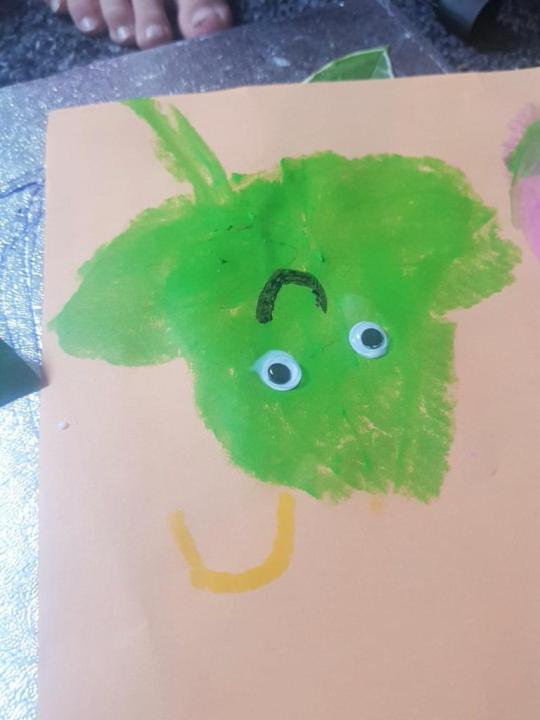

Sarah was really excited to go for a nature walk it was really calm, peaceful, and soothing effect for physically and mentally it also helps to change our moods by listening sounds of birds and taking a fresh breath and she also ask questions regarding squirrels and insects.
0 notes
Text
Fantasy Cardboard home
Play is essential for the physical and mental growth and development of children, as it has various impacts on them. It fosters suspense and curiosity, enhances confidence, and improves social skills. Play is an interactive process through which children learn from an early age. Methodology:
In our case, Sarah, who recently arrived from Pakistan, was missing her toys and dollhouses in England. To address this, we decided to create a dollhouse using cardboard boxes. 1: We collected different packing boxes from heaters, fridges, microwaves, and other items. 2: Then we joined these boxes together using white tape, considering their sizes and the desired stories for the dollhouse.
To accommodate the quantity and sizes of the boxes, we created a two-story dollhouse. We secured the boxes with tape and also used glue.
3: To decorate the dollhouse, we wrapped all the boxes with gift paper, using two new pieces of paper purchased from a shop for the top part. The top was adorned with pink gift paper.
Outcome:




Throughout the process, Sarah actively participated under my observation and guidance. Sarah was genuinely excited about the dollhouse she helped create. She placed her dolls inside, along with other items like unicorns, creating a lively and imaginative play setting. She eagerly invited her friend to see her new dollhouse. Children enjoy learning through play and experimentation. This activity was not only playful and enjoyable but also allowed both of us to explore our creativity and innovation using recycled materials.
Note: When engaging in playful activities with children, it is important to prioritize their safety and provide appropriate supervision.
0 notes
Text
Sarah’s Organic Impressions / Farm to Art Gallery
Vegetable Art: This activity aims to foster creativity and explore curiosity, experimentation, and observational skills by examining different textures, shapes, and patterns found in vegetables. It also encourages artistic expression through the use of vegetables as a primary medium, along with cutters, paints, and paper.
Methodology:
1. Begin by cutting the vegetables with a knife or paper cutter.
2. Carefully cut them in half, ensuring a straight cut to achieve a good impression.
3. Apply paint to the vegetables using a paintbrush.
4. Press the painted vegetables firmly onto a piece of paper.
5. Observe the resulting impression, which should display a unique pattern.
Outcomes:
This activity utilizes vegetables as the primary resource, allowing for an exploration of various aspects such as textures, food waste awareness - global food wastage issue, sensory experiences, and the importance of natural resources.




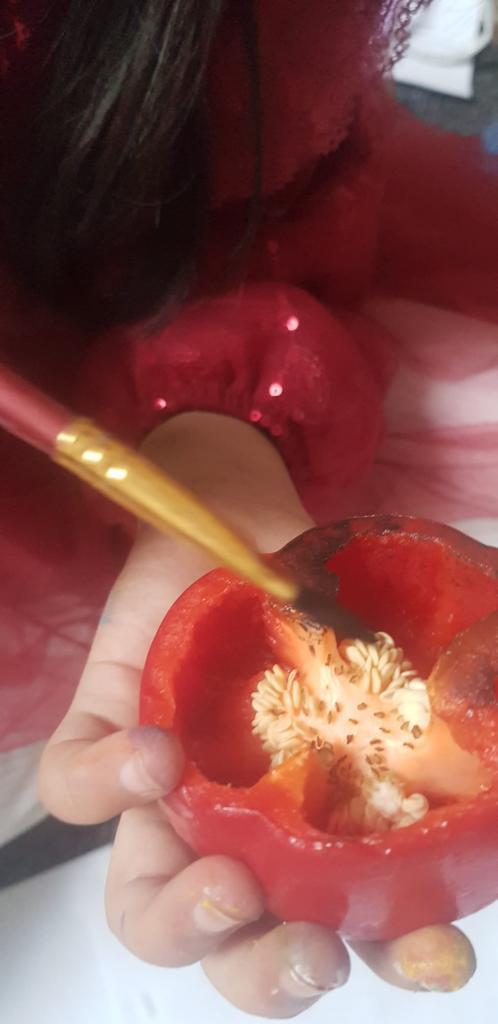
Reflections:
Sarah expressed surprise and delight upon seeing the impressions created by the vegetables. She thoroughly enjoyed participating in this activity.
Note: Please be cautious while handling knives and cutting utensils and ensure appropriate supervision and safety measures are in place, especially when involving children in this activity.
0 notes
Text
Save Earth
As we are currently facing global warming, climate change, deforestation, and the endangerment of various animal species, it is crucial to educate our children about how they can contribute to saving the Earth. Through art, we can convey the importance of their beloved planet and teach them about the 3Rs (reduce, reuse, recycle) and other factors that can help in its preservation.
Methodology:
1. Take a small piece of a cardboard box.
2. Cut it into the shape of a circle.
3. Mark the green and blue areas on the circle.
4. Have the kid paint the green and blue sections.
5.paste endangered animals stickers and googly eyes.
6.cut two trees with brown paper and paste on the earth to show deforestation.
"Childhood is the world of imagination and play, where anything is possible, and dreams can come true." - Dorothea Lange.
Outcomes:
Sarah will know the importance of Earth through this activity that how they can take care of their environment by saving trees, endangered animals, and ecosystems. Through this activity, she will also know the names of endangered animals and the green and blue parts of the Earth.
This collaborative art project bring people together and develop sense of responsibility for the environment.
Strength:
Art has the power to captivate and evoke emotions through this activity she will also have a strong connection with the earth, endangered animals, and a sense of responsibility to save lovely Earth.
Reflections: It will also develop environmental responsibilities, and awareness about the earth that how she can keep her Earth neat and clean. through this activity, she will know that to be a good citizen she should grow plants save water, and not throw litter.


0 notes
Text
Marion Richardson’s writings and writing pattern
As part of our Global Innovations core module and with guidance from our course leader, Cathy, I came across the work of Marion Richardson, a notable British artist and educator. Marion Richardson, who made significant contributions to handwriting education as a primary school teacher at Dudley Girls High School in the United Kingdom, focused on fostering children's creative expression through handwriting. Given Sarah's current learning of phonics and writing at school, I decided to introduce her to Marion Richardson's handwriting patterns in an effort to enhance her handwriting skills and artistic expression.
Methodology:
To improve her writing skills, I drew patterns by myself.
She started writing by copying the patterns with different colored pencils and by using scratching paper.
She developed her unique writing patterns with my guidance.
she also tried to write her name by using her writing styles.
This activity aims to enhance Sarah's letter formation and improve her writing skills. Through the repeated tracing of letters, she will have the opportunity to reinforce her memory and strengthen her writing abilities. Engaging in this activity will boost her confidence and advance her writing skills, while also enhancing her visual and kinesthetic learning. Furthermore, it will provide her with the means to develop her own unique writing style.
Outcomes:
The outcomes of this activity include improved writing skills, increased confidence, enhanced self-expression, and the development of transferable skills. It is worth noting that students in Pakistan also follow this writing style to improve their writing abilities. For this activity, Sarah utilized scratch paper to practice and refine her handwriting.
Reflections :
Marion Richardson's writing style has enabled Sarah to write with ease and rhythm which develop a unique and distinctive style that develops a child's personality and character.
Strength:
Richardson's writing style foster to love for writing and learning she really enjoyed this writing style which will help to positive experiences and encourage engagement and motivation to calligraphy writing. This approach will also allow to develop her own writing stylepromoting self-expressionn and creativity in her written work.
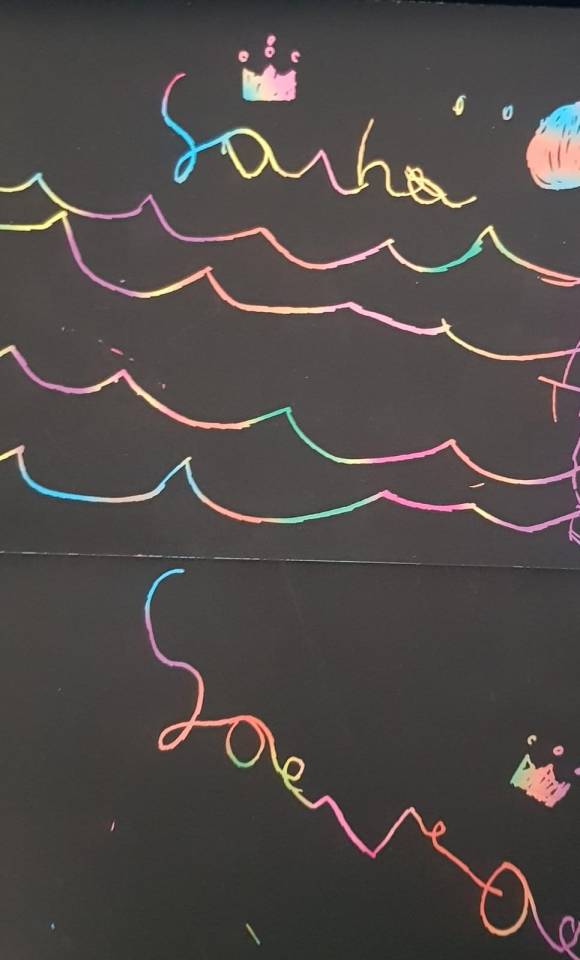

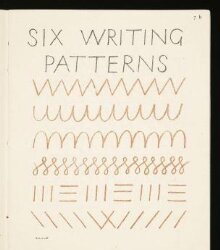

References: 1: Sassoon, Rosemary, and Rosemary Sassoon. Marion Richardson: Her Life and Her Contribution to Handwriting. 1st ed. Bristol: NBN International, 2014. Print.
0 notes
Text
Children Development through Art
Monster Tales
Objectives: The main purpose of the monster story is multifaceted. It will enhance the child’s cognitive abilities and out-of-the-box thinking. The child will be able to express what they feel about monsters which will enhance their confidence to freely express. This will also help to examine the emotional and cognitive feelings of children. It will also help us to show their opinion about monsters and overall supernatural beings.
Resources: Charcoal pencils and brown paper.
Methodology:
First, we used brown paper for drawing.
We used charcoal pencils of white and black colours.
Children started to draw weird images to express their views, about supernatural beings, converting their thoughts and ideas into actual images.
Outcomes & reflection:
Children learned how to manage and handle emotional experiences when encountered with unexpected scenarios. It identified and triggered the cognitive process which involves sketching down scary and feared thoughts, expressing their ideas and fears through drawing. This will also enhance imagination and problem-solving ability.


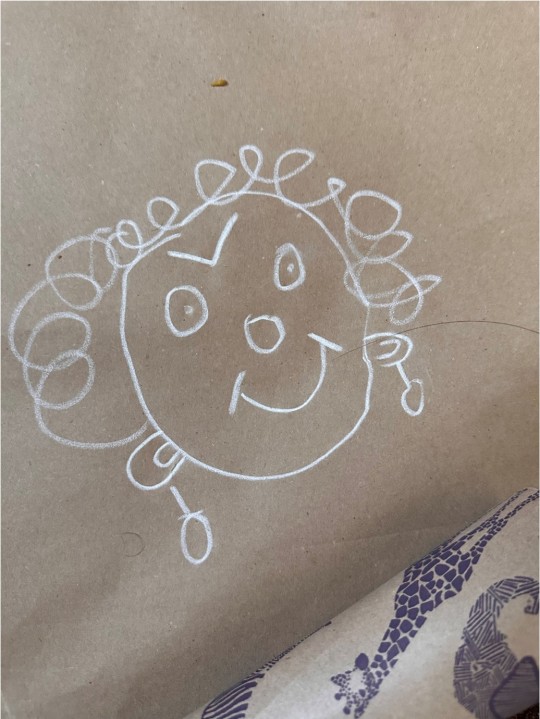

unknown
Through this activity, children learned how they can describe their imaginations, fears, and thoughts about ghosts and witches. They can also write stories with drawings/images, enhancing their story writing abilities.
As Wilson claims people wrongly believe that children’s drawings are attempts to imitate the world (Wilson 1982).
Sarah’s view on art:
During my holidays, I’ve done so many art activities with my mom, First, we went to purchase required materials for the art activities. We bought water-colours, stick paints, pom poms, googly eyes, glue, feathers, and a lot of other stuff. I was super excited to use those materials and I can’t stop myself to use all the things we bought. I had many ideas in my mind which and applied some of them during the art activities. I want to play with more colours, and I want to learn how I can paint on the disposable glass and paste different items with glue on materials.
“More than ever, we need to create a space for our children to explore themselves and their world, a safe space to take risks and face challenges, and a space for their imagination.”
Tate Britain, 2014.
Tate Britain, 2014. Opinion: learning from our children. Tate Etc.Issue 34: Summer 2015
0 notes
Text
Trash to treasure Apron
As we started our work we thought about how if we don’t have an apron We can use bin bag as an apron by using recycle material to save our environment which cost cheap easily accessible protective garment for children while engaging in messy artwork because it will help us to use this apron as a traditional apron which will help to save her clothes from paints, glue scissor, and other art materials.

Outcomes:
It will help us to protect children’s clothing from getting stained or messy during art activity it would be also lightweight and easy to wear and after using it we can discard it it will cost nothing and at home we can make it easily.
Methodology:
We have used just a few things to make an apron. Firstly we take a bin bag, scissors and tape. We cut it from its bottom and for the child’s head to pass through. Then I adjust its size according to its height from its handle we cut from the top and put scotch tape on it to adjust according to its body. Then allow them to engage in art activities and encourage them to be creative and explore different ways. After doing an art activity you can easily remove it from your body and can trash it as well.
Reflections:
Sarah was really excited about art activities and she was feeling confident and creative about herself as we were ready to do experiments we were curious about new learning so there were plethora of ideas coming to her mind by watching art material.
Bag Paper Home
Objectives: Sarah will be able to make her dream house by using a brown paper bag. She will also think about materials, and papers and how she can be able to use discard things by using her creativity.
Methodology:
first, we cut brown paper bag handles.
then she folds its bottom side to make the roof of the house with my help.
I cut black and white paper for windows and door of the house.
Sarah gave the impression of windows and doors with paint.
she started pasting windows and doors on brown paper.
and did brown paint on its top by drawing bricks.
She also drew colorful flowers around the door to give a beautiful impression.
When adorning is complete put your hand inside to open it and stand it on the floor or any flat surface you can also fill it with some crumpled-up papers and also draw a lawn in front of the house as well.
Outcomes:
It will help to explore her imagination, creativity, and ideas she can also use them for Play after finishing her art activity.
Reflections:
she made a paper bag house enthusiastically and she has shown her house to her friend she was feeling proud that she can use her household and cheap things she can create anything instead of buying.
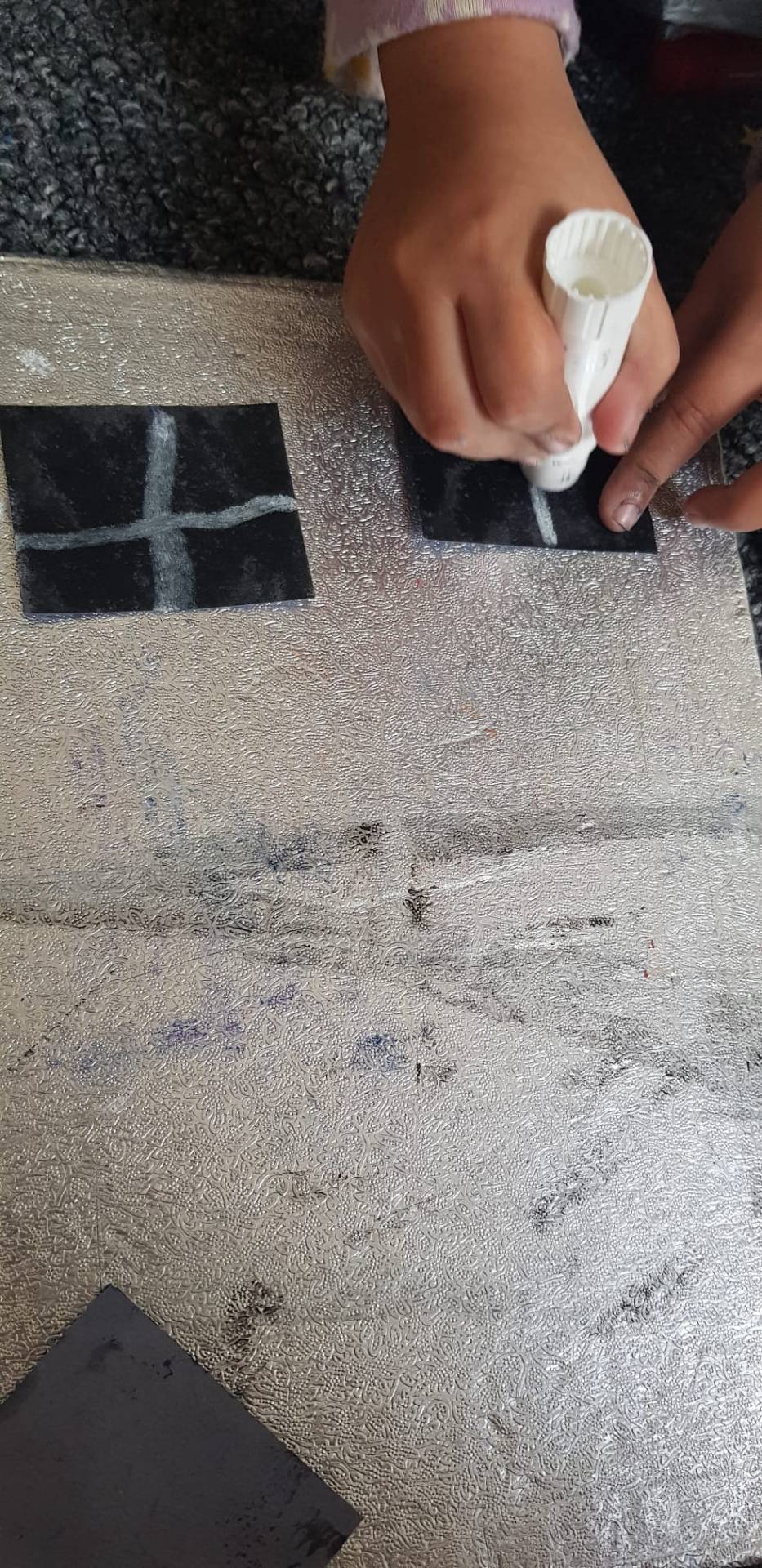

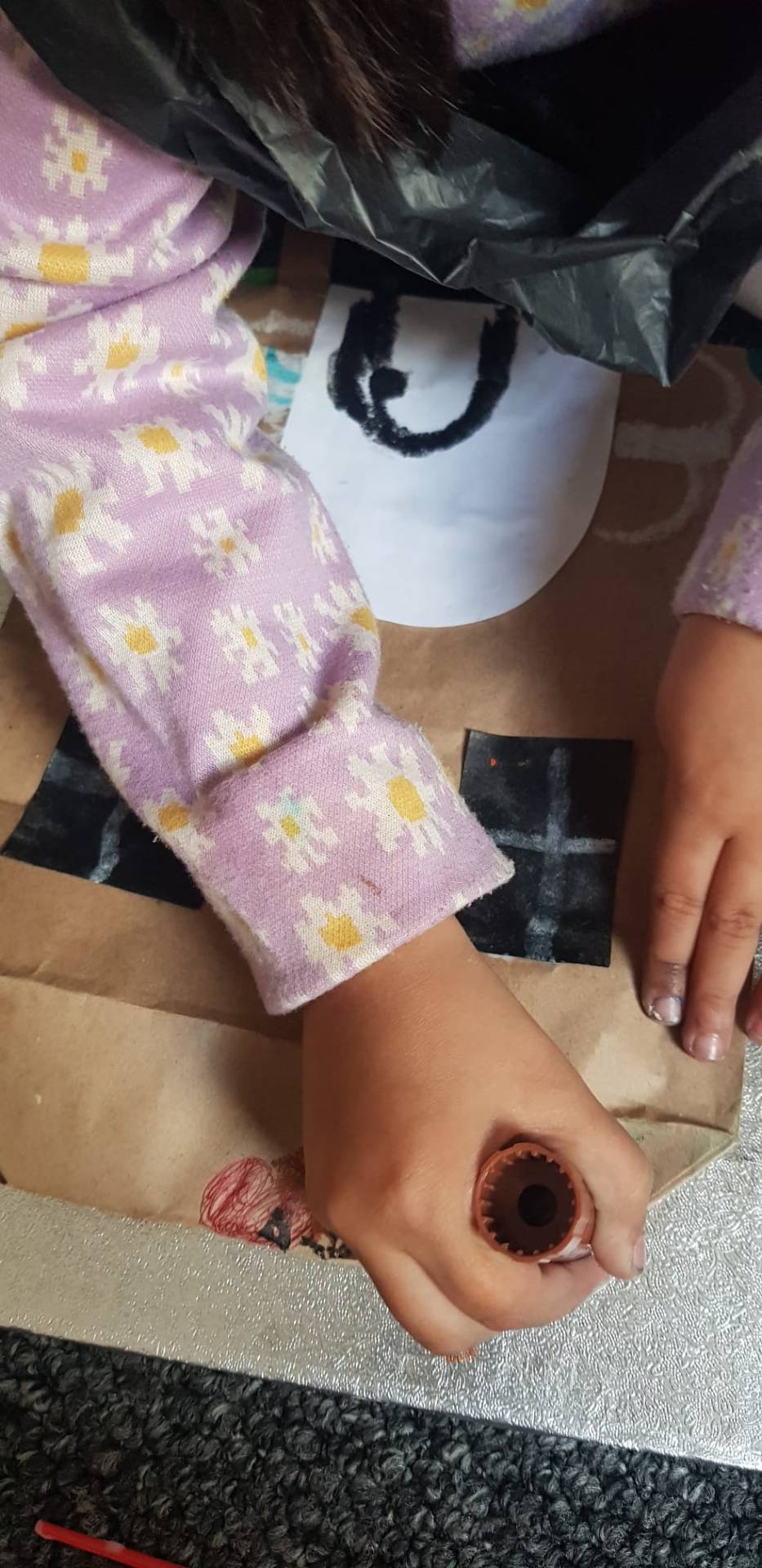
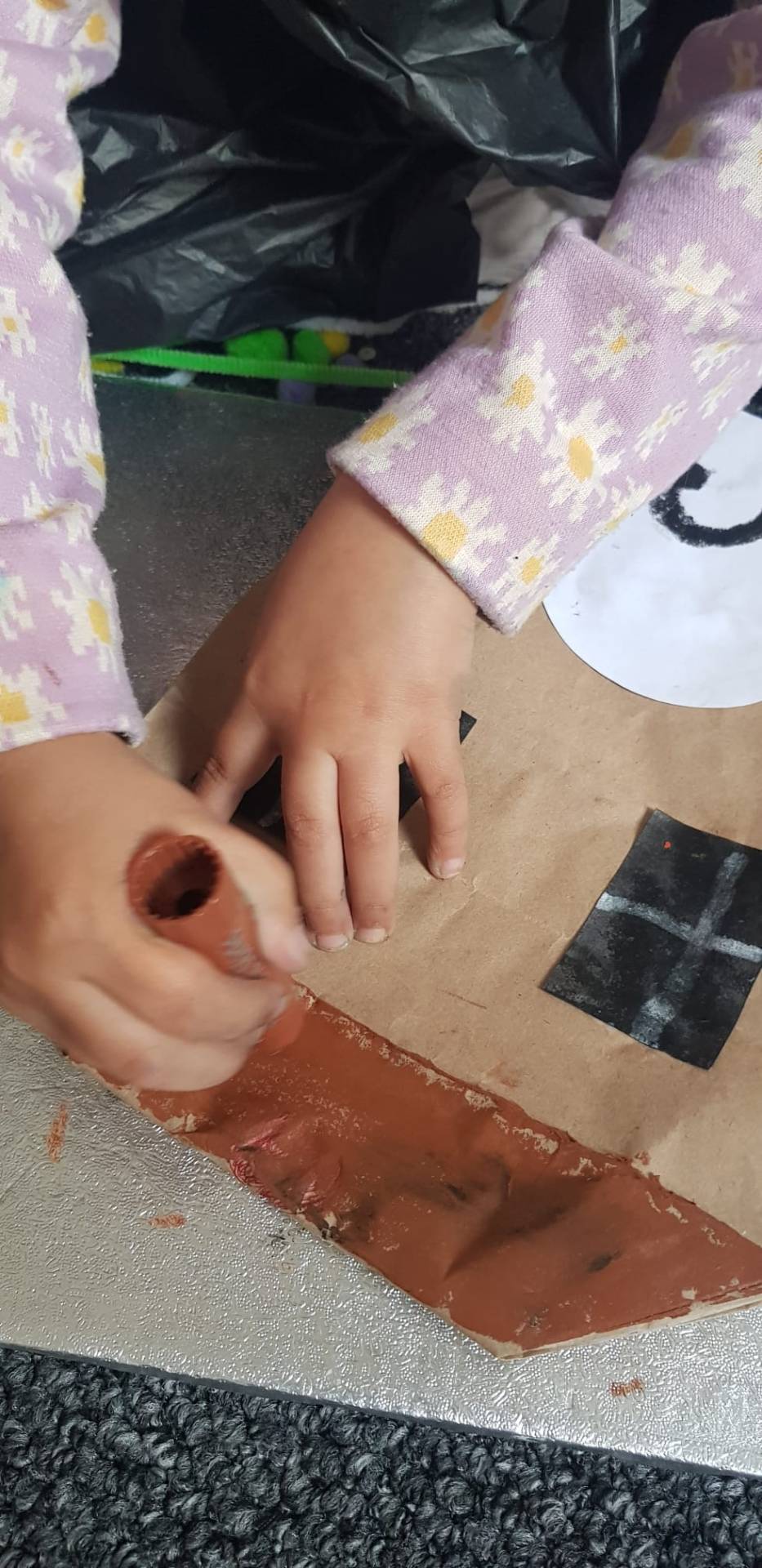

Conclusion:
Arts is related to everyday life and it involves individuals' creativity and personal experiences. Arts is linked to culture, heritage, and surroundings. Varkoy mentions the German term Bildung and links it to arts education which means a continuous process of personal development with no defined end goals. relating it to cultural heritage arts enroots in it. In our case, Sarah's artwork and aesthetics also depict her culture and have an influence on the environment of her home back in Pakistan but as learning is a continuous process and after moving to a new country, she still is embracing new culture and environment and developing as an individual and she still as a lot to learn and for me it was also a great opportunity to work with my daughter make memorable moments for me talking, sharing ideas creativity, development and imaginations that gave me the meaning and have worth rather than art pieces.
Global Art provides a rich and transformative experience which develop a positive change the shape of a child development.
The Routledge International Handbook of the Arts and Education. (2014). United Kingdom: Taylor & Francis.
0 notes